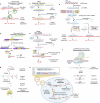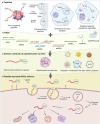Nucleic acid drugs: recent progress and future perspectives
- PMID: 39609384
- PMCID: PMC11604671
- DOI: 10.1038/s41392-024-02035-4
Nucleic acid drugs: recent progress and future perspectives
Abstract
High efficacy, selectivity and cellular targeting of therapeutic agents has been an active area of investigation for decades. Currently, most clinically approved therapeutics are small molecules or protein/antibody biologics. Targeted action of small molecule drugs remains a challenge in medicine. In addition, many diseases are considered 'undruggable' using standard biomacromolecules. Many of these challenges however, can be addressed using nucleic therapeutics. Nucleic acid drugs (NADs) are a new generation of gene-editing modalities characterized by their high efficiency and rapid development, which have become an active research topic in new drug development field. However, many factors, including their low stability, short half-life, high immunogenicity, tissue targeting, cellular uptake, and endosomal escape, hamper the delivery and clinical application of NADs. Scientists have used chemical modification techniques to improve the physicochemical properties of NADs. In contrast, modified NADs typically require carriers to enter target cells and reach specific intracellular locations. Multiple delivery approaches have been developed to effectively improve intracellular delivery and the in vivo bioavailability of NADs. Several NADs have entered the clinical trial recently, and some have been approved for therapeutic use in different fields. This review summarizes NADs development and evolution and introduces NADs classifications and general delivery strategies, highlighting their success in clinical applications. Additionally, this review discusses the limitations and potential future applications of NADs as gene therapy candidates.
© 2024. The Author(s).
Conflict of interest statement
Competing interests: The authors declare no competing interests.
Figures






Similar articles
-
The Black Book of Psychotropic Dosing and Monitoring.Psychopharmacol Bull. 2024 Jul 8;54(3):8-59. Psychopharmacol Bull. 2024. PMID: 38993656 Free PMC article. Review.
-
Management of urinary stones by experts in stone disease (ESD 2025).Arch Ital Urol Androl. 2025 Jun 30;97(2):14085. doi: 10.4081/aiua.2025.14085. Epub 2025 Jun 30. Arch Ital Urol Androl. 2025. PMID: 40583613 Review.
-
Nucleic Acid Nanocapsules as a New Platform to Deliver Therapeutic Nucleic Acids for Gene Regulation.Acc Chem Res. 2025 Jul 1;58(13):1951-1962. doi: 10.1021/acs.accounts.5c00126. Epub 2025 Jun 9. Acc Chem Res. 2025. PMID: 40491030
-
[Research progress of peptide recognition-guided strategies for exosome isolation and enrichment].Se Pu. 2025 May;43(5):446-454. doi: 10.3724/SP.J.1123.2024.10015. Se Pu. 2025. PMID: 40331609 Free PMC article. Review. Chinese.
-
Short-Term Memory Impairment.2024 Jun 8. In: StatPearls [Internet]. Treasure Island (FL): StatPearls Publishing; 2025 Jan–. 2024 Jun 8. In: StatPearls [Internet]. Treasure Island (FL): StatPearls Publishing; 2025 Jan–. PMID: 31424720 Free Books & Documents.
Cited by
-
Progress and potential of nanobubbles for ultrasound-mediated drug delivery.Expert Opin Drug Deliv. 2025 Jul;22(7):1007-1030. doi: 10.1080/17425247.2025.2505044. Epub 2025 May 18. Expert Opin Drug Deliv. 2025. PMID: 40353846 Review.
-
Dual threat: Susceptibility mechanisms and treatment strategies for COVID-19 and bacterial co-infections.Comput Struct Biotechnol J. 2025 May 22;27:2107-2122. doi: 10.1016/j.csbj.2025.05.033. eCollection 2025. Comput Struct Biotechnol J. 2025. PMID: 40502935 Free PMC article. Review.
-
Protein Kinases as Mediators for miRNA Modulation of Neuropathic Pain.Cells. 2025 Apr 11;14(8):577. doi: 10.3390/cells14080577. Cells. 2025. PMID: 40277902 Free PMC article. Review.
-
LincRNA-ASAO promotes dental pulp repair through interacting with PTBP1 to increase ALPL alternative splicing.Stem Cell Res Ther. 2025 Mar 26;16(1):149. doi: 10.1186/s13287-025-04274-w. Stem Cell Res Ther. 2025. PMID: 40140936 Free PMC article.
-
NOX-NOS crosstalk in the liver-brain axis: Novel insights for redox regulation and neurodegenerative diseases.Redox Biol. 2025 Aug 6;86:103807. doi: 10.1016/j.redox.2025.103807. Online ahead of print. Redox Biol. 2025. PMID: 40782521 Free PMC article. Review.
References
-
- Zhang, S. et al. The mechanistic, diagnostic and therapeutic novel nucleic acids for hepatocellular carcinoma emerging in past score years. Brief. Bioinform.22, 1860–1883 (2021). - PubMed
-
- Smith, C. I. E. & Zain, R. Therapeutic oligonucleotides: state of the art. Annu. Rev. Pharmacol. Toxicol.59, 605–630 (2019). - PubMed
-
- Friedmann, T. & Roblin, R. Gene therapy for human genetic disease? Science175, 949–955 (1972). - PubMed
Publication types
MeSH terms
Substances
Grants and funding
LinkOut - more resources
Full Text Sources

